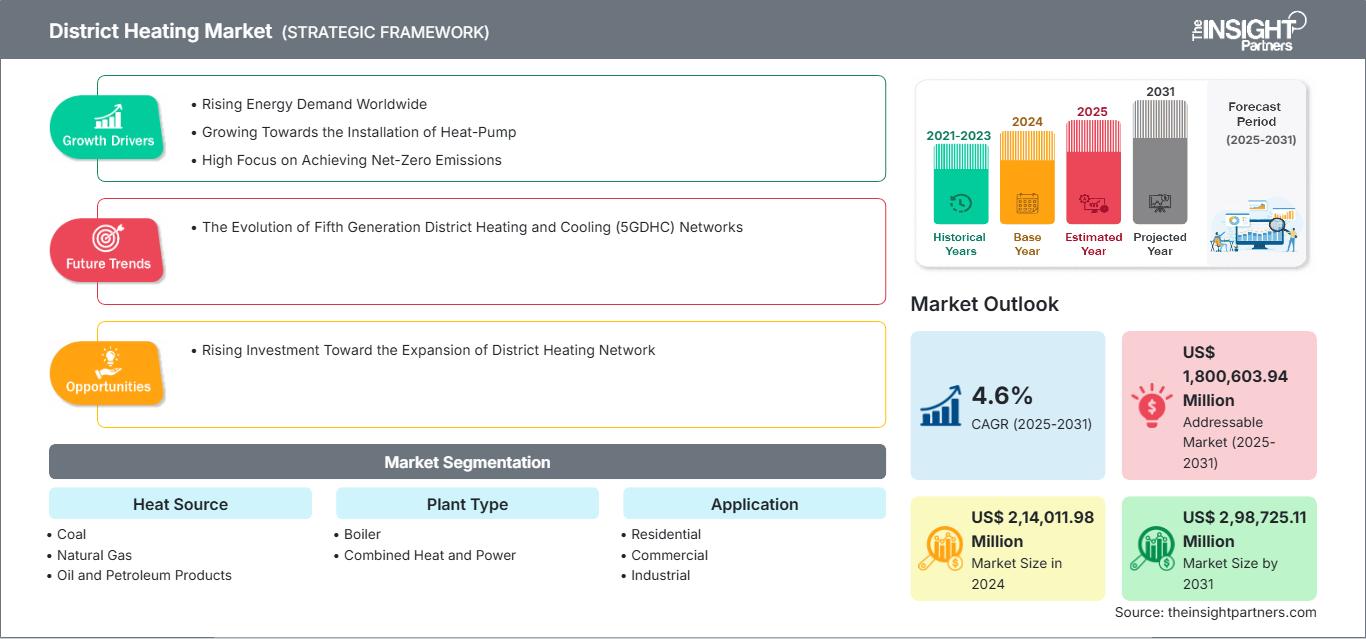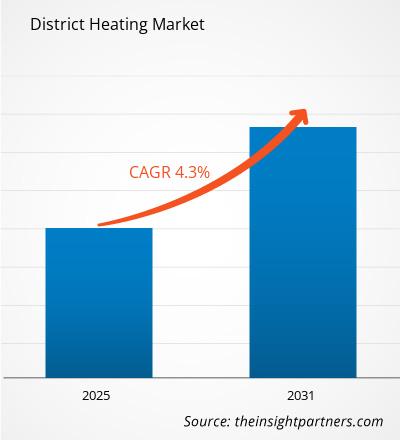区域供热市场规模预计将从 2024 年的 2140.1198 亿美元增至 2031 年的 2987.2511 亿美元。预计该市场在 2025 年至 2031 年期间的复合年增长率为 4.6%。全球能源需求的不断增长可能会在未来几年为市场带来新的趋势。
区域供热市场分析
区域供热是一种水基供暖系统,它利用来自生物燃料、垃圾和工业废热等当地来源的多余可再生能源。它从中央能源工厂产生热能,并将其分配给多栋建筑。该系统支持能源工厂产生蒸汽或热水,并通过隔热良好的地下热管道网络全天候分配。热能流向建筑物的供暖系统,从而无需在各个建筑物中安装锅炉。区域供热是至关重要的基础设施,它能够提高能源效率、减少排放、提高燃料供应灵活性、简化建筑运营和维护并节省成本。它在向循环经济转型和减少温室气体排放方面发挥着重要作用。区域供热可以释放电网容量,并可作为建筑和工业领域化石燃料的可再生替代品,从而增加其安装量。
区域供热市场概览
不断增长的能源需求、不断增长的热泵投资和安装量以及对实现净零排放的高度关注,推动了全球区域供热的需求。城市地区智慧城市项目的蓬勃发展以及区域供热管网扩建的投资进一步推动了市场的增长。蓬勃发展的研发活动、工业过程余热利用的不断增长以及第五代区域供热和制冷 (5GDHC) 网络的不断发展,预计将为市场带来未来的增长机会。
区域供热市场根据热源、设备类型、应用和地域进行细分。根据热源,市场分为煤炭、天然气、石油及石油产品和其他。根据工厂类型,市场分为锅炉、热电联产 (CHP) 和其他。根据应用,区域供热市场分为住宅、商业和工业。按地区划分,区域供热市场分为北美和欧洲。欧洲占据较大市场份额,其次是亚太地区和北美。由于供热管网的扩张、智慧城市项目的兴起、物联网和 5G 等先进技术的融合、政府的利好举措以及对区域供热管网开发和扩建的资金投入,欧洲的区域供热市场正经历着巨大的增长。
自定义此报告以满足您的要求
您将免费获得任何报告的定制,包括本报告的部分内容,或国家级分析、Excel 数据包,以及为初创企业和大学提供超值优惠和折扣
区域供热市场: 战略洞察

- 获取本报告的主要市场趋势。这个免费样本将包括数据分析,从市场趋势到估计和预测。
您将免费获得任何报告的定制,包括本报告的部分内容,或国家级分析、Excel 数据包,以及为初创企业和大学提供超值优惠和折扣
区域供热市场: 战略洞察

- 获取本报告的主要市场趋势。这个免费样本将包括数据分析,从市场趋势到估计和预测。
区域供热市场驱动力与机遇
全球能源需求不断增长
区域供热厂(例如锅炉和热电联产)用于集中供热(通常以热水或蒸汽的形式),并通过相互连接的绝缘管道网络向住宅、商业和工业建筑输送热量。根据国际能源署 (IEA) 2025 年 3 月的数据,由于电力消耗的增加以及可再生能源和天然气供应的不断增长,能源需求正在飙升。 2024 年,全球能源消耗量增长 2.2%,高于 2013 年至 2023 年期间 1.3% 的年平均需求增幅。2024 年,中国(40.6 亿吨油当量)、美国(21.72 亿吨油当量)、印度(11.35 亿吨油当量)、俄罗斯(8.38 亿吨油当量)、日本(3.91 亿吨油当量)、巴西(3.36 亿吨油当量)等发展中经济体和其他新兴经济体占全球能源需求增长的 80% 以上。在这些国家中,中国的能源消耗量在 2023 年增长了约 3%。区域供热解决方案的可扩展性使其成为人口密集城市地区可靠供热的热门选择。这些解决方案向大量建筑输送适量的热量,同时最大限度地减少整体能源浪费。因此,对可持续解决方案的日益增长的需求和不断上升的能源消耗促使住宅、商业和工业领域采用区域供热解决方案。这些解决方案支持各行各业以最优方式利用能源,并推动它们减少温室气体排放。
区域供热管网扩建投资飙升
城市和政府致力于升级区域供热管网,并将热能输送到多栋建筑。各国政府正在建设智慧城市,这需要集中供热系统来产生和储存热量,收集城市废热以供进一步利用,并减少能源损失。不断增长的能源需求和对合适供热系统日益增长的需求,需要大量投资来扩建区域供热管网。各国政府正在投资扩建区域供热管网,以满足个人的能源需求。根据精益能源线 (Energy Wire) 2024 年 9 月发布的数据,到 2045 年,德国每年需要投资近 50 亿欧元(55.6 亿美元),为三分之一的住宅提供区域供热。根据世界核协会2023年2月的数据,中国在核能热源项目中投资了3.9亿元人民币(约合5700万美元),用于在核电站内建设供热管网和泵站。这项投资将使供热能力提升至970万吉焦耳(GJ),为1300万平方米的区域供热,满足100万居民的供热需求,并减少165万吨二氧化碳排放。区域供热管网的扩容可以降低燃料供应、维护和运行效率的成本。
对区域供热系统的投资,例如新增管道、发电厂和配送系统,使更多家庭和企业能够获得低成本、高效的供暖。因此,重点关注减排和区域供热网络的扩建,以减少热量分配过程中的能量损失并提高网络效率,预计将为市场创造未来的增长机会。
区域供热市场报告细分分析
有助于得出区域供热市场分析的关键细分是热源、工厂类型和应用。
- 就热源而言,市场分为煤炭、天然气、石油和石油产品等。天然气部分在 2024 年占据了市场主导地位。
- 按工厂类型,市场分为锅炉、热电联产和其他。热电联产部分在 2024 年占据了市场主导地位。
- 根据应用,市场分为住宅、商业和工业。 2024 年,住宅市场占据了市场主导地位。
区域供热市场份额按地区分析
区域供热市场分为五大区域:北美、欧洲、亚太地区 (APAC)、中东和非洲 (MEA) 以及南美和中美 (SAM)。2024 年,欧洲占据了市场主导地位,其次是亚太地区和北美。
欧洲的区域供热市场分为德国、法国、英国和意大利。政府和科技公司越来越意识到整合可持续解决方案的好处,并加大对区域供热网络扩建的投资,这推动了对这些系统的需求。根据 Fern 2025 年 3 月的数据,丹麦大哥本哈根公用事业公司 (HOFOR) 正在对其区域供热网络进行电气化改造,该网络之前基于生物质和垃圾燃烧。该公用事业公司计划安装新的热泵,其中三台已经安装完毕。 HOFOR公用事业公司将投资30亿丹麦克朗(4.18亿美元),到2033年再安装10台热泵。该装置将提供300兆瓦的供热能力,使哥本哈根区域供热对生物质的依赖减少约三分之一。2024年8月,丹麦区域供热委员会(DBDH)发布的数据指出,德国需要在区域供热方面至少投资435亿欧元(476.4亿美元),才能在2030年前实现其气候目标。这项投资将支持德国扩大供热能力、生产可再生能源,并在2045年前实现气候中和。将热泵和其他电气化系统纳入区域供热网络,有助于公用事业行业降低碳排放并提高供热网络效率。因此,不断增加的投资和政府对净零转型的关注推动了欧洲区域供热市场的增长。
区域供热市场区域供热市场
The Insight Partners 的分析师已详尽阐述了预测期内影响区域供热市场的区域趋势和因素。本节还讨论了北美、欧洲、亚太地区、中东和非洲以及南美和中美的区域供热市场细分和地域分布。
区域供热市场报告范围
| 报告属性 | 细节 |
|---|---|
| 市场规模 2024 | US$ 2,14,011.98 Million |
| 市场规模 2031 | US$ 2,98,725.11 Million |
| 全球复合年增长率 (2025 - 2031) | 4.6% |
| 历史数据 | 2021-2023 |
| 预测期 | 2025-2031 |
| 涵盖的领域 |
By 热源
|
| 覆盖地区和国家 | 北美
|
| 市场领导者和主要公司简介 |
|
区域供热市场参与者密度:了解其对业务动态的影响
区域供热市场正在快速增长,这得益于终端用户需求的不断增长,而这些需求的驱动因素包括消费者偏好的不断变化、技术进步以及对产品优势的认知度不断提高。随着需求的增长,企业正在扩展产品线,不断创新以满足消费者需求,并抓住新兴趋势,从而进一步推动市场增长。

- 获取 区域供热市场 主要参与者概述
区域供热市场新闻及最新发展
区域供热市场评估通过收集一手和二手研究后的定性和定量数据进行,这些数据包括重要的公司出版物、协会数据和数据库。区域供热市场的一些关键发展如下:
- Fortum 同意利用其仿真专业知识支持芬兰科技公司 Steady Energy 的区域供热核反应堆的开发。目标是使用 Apros 软件为 Steady Energy 的 LDR-50 反应堆创建一个全面的数字孪生。(来源:Fortum,新闻稿,2025 年 3 月)
- 法国公用事业公司 Engie SA(EPA:ENGI)旗下的 Engie Polska 决心在 2025 年底前逐步淘汰其波兰供热厂的煤炭,改用生物质、天然气或废热。到2026年,该公司位于波兰北部城镇斯武普斯克的工厂预计将利用可再生能源、废热和高效热电联产产生80%的热量。为此,该公司正在将燃煤锅炉改造为生物质锅炉,并安装热泵,以充分利用污水处理后产生的废热潜力。 (来源:Engie SA,新闻稿,2025 年 3 月)
区域供热市场报告覆盖范围和可交付成果
《区域供热市场规模和预测(2021-2031)》对市场进行了详细的分析,涵盖以下领域:
- 区域供热市场规模以及涵盖范围内所有关键细分市场的全球、区域和国家/地区层面的预测
- 区域供热市场趋势以及市场动态,例如驱动因素、限制因素和关键机遇
- 详细的 PEST 和 SWOT 分析
- 区域供热市场分析,涵盖关键市场趋势、全球和区域框架、主要参与者、法规和最新市场发展
- 行业格局和竞争分析,涵盖市场集中度、热图分析、知名参与者和区域供热市场的最新发展
- 详细的公司简介
- 历史分析(2 年)、基准年、预测(7 年)及复合年增长率
- PEST和SWOT分析
- 市场规模、价值/数量 - 全球、区域、国家
- 行业和竞争格局
- Excel 数据集
近期报告
相关报告
客户评价
购买理由
- 明智的决策
- 了解市场动态
- 竞争分析
- 客户洞察
- 市场预测
- 风险规避
- 战略规划
- 投资论证
- 识别新兴市场
- 优化营销策略
- 提升运营效率
- 顺应监管趋势




















 获取免费样品 - 区域供热市场
获取免费样品 - 区域供热市场